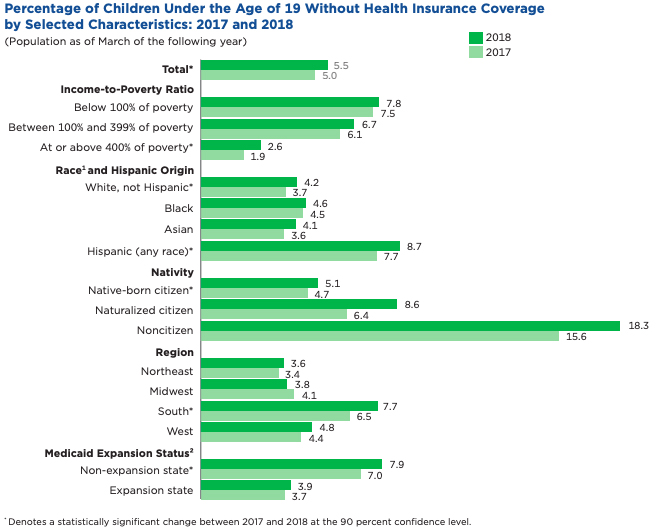As Rate of Children Without Health Insurance Rises in 2018, Researchers Ask: Is Trump’s Immigration Crackdown to Blame?

The number of American children covered by health insurance took a tumble last year, a change analysts theorized could have been motivated — at least in part — by the Trump administration’s aggressive immigration crackdown.
Census data released last week revealed that nearly half a million fewer children had health insurance last year than in 2017, a change that was driven primarily by a decline in those covered through Medicaid and the Children’s Health Insurance Program (CHIP). Hispanic children, who historically have lower health insurance rates, saw the largest reduction in coverage, declining 1 percentage point from 7.7 percent uninsured in 2017 to 8.7 percent in 2018.
Children living in the South were less likely to be insured than those in other regions. Among children in the South, the uninsured rate increased 1.2 percentage points between 2017 and 2018 to 7.7 percent. The uninsured rate change for children in other regions wasn’t statistically significant.
Randy Capps, director of research for U.S. programs at the Migration Policy Institute, said it’s likely that children in immigrant families who are U.S. citizens drove a large share of the drop in public health coverage among Hispanics. In fact, health care providers in states like Texas have reported an increase in undocumented parents opting their citizen children out of government programs over deportation concerns. Such situations could arise, Capps said, if undocumented parents worry that enrolling their children in programs like Medicaid “might either reveal themselves to the immigration authorities or make it harder for them to get green cards.”

The share of American children without health coverage is relatively small. About 4.3 million children — or 5.5 percent of Americans under the age of 19 — were uninsured in 2018. The child health insurance rate also declined in 2017, a change that surprised researchers after years of continuous growth.
Students’ access to health coverage comes with significant ramifications for schools. Children with health insurance are less likely to miss school than those without coverage and are more likely to finish high school and attend college.
“The effects are much broader than just the health of a child, but they link right up with education overall,” said Kelly Whitener, an associate professor at the Georgetown University’s Center for Children and Families. She also pointed to recent federal education policy changes as a reason to improve health care coverage among students. Under the Every Student Succeeds Act, 36 states and the District of Columbia chose to use chronic absenteeism as a school accountability metric.
For the past several years, health researchers at Georgetown University have been sounding the alarm on potential ties between the Trump administration’s immigration crackdown and access to health insurance among children. But other factors are likely at play as well. In 2017, federal spending on CHIP expired and Congress didn’t approve new funding for the program until early 2018. And efforts to repeal the Affordable Care Act likely played a role, Whitener said, because “that certainly wasn’t a welcome mat for people to come and sign up for coverage.”
Among non-Hispanic white children, 4.2 percent were uninsured last year, a 0.5 percentage point increase from 2017. The change in uninsured rates for non-Hispanic white children and Hispanic children between 2017 and 2018 was not statistically significant, according to the census report.
Though deportation concerns could have dampened health care access for U.S.-born children with undocumented parents, the census data don’t point to a similar effect among nonresidents of all ages, Capps said. The insurance rate for nonresidents declined last year, but most of that drop was observed in private insurance, such as employer-sponsored health coverage. Undocumented immigrants are typically ineligible for public benefits, though they’re able to purchase private insurance.
Capps cautioned that the labor market could also explain the drop in private coverage among noncitizens. It’s possible that immigrant parents “either lost jobs that had health insurance coverage or they entered the labor market and got new jobs that didn’t have coverage, or shifted from jobs that had coverage to jobs that didn’t have coverage,” he said.
Looking forward, however, it’s possible that a major immigration policy shift could make the situation worse for nonresidents seeking green cards, researchers said. As the Trump administration plans to move forward next month with a policy to withhold green cards from legal immigrants who rely on public benefits, researchers offered advice to parents: Don’t end your child’s health coverage out of fear.
Initial drafts of the administration’s “public charge” rule would have made it more difficult for immigrants to obtain green cards if their children, including those born in the U.S., received public benefits through programs like Medicaid or CHIP. But the final rules, set to begin in mid-October, don’t refer to the use of public benefits by children, although analysts worry the damage might already have been done.
Confusion stemming from earlier drafts of the public charge rule could create a “chilling effect” that could prevent legal immigrants from enrolling their children in public benefits, researchers said. In fact, that chilling effect may already be underway. In a recent survey by the Urban Institute, about 14 percent of adults in immigrant families said they or a family member did not participate in a government benefit program such as Medicaid last year because they feared it could put future green cards at risk. Hispanic adults in immigrant families were twice as likely as those in other demographic groups to report a chilling effect. So were adults living with children.
It’s unclear whether anxieties over the public charge rule affected the uninsured rate in 2018, said Stephen Zuckerman, a senior fellow and vice president for health policy at the Urban Institute. But the census data are “certainly consistent with the findings that a chilling is leading some people to either not participate in programs for themselves or for members of their family,” he said.
Whitener said it will be important to track whether the public charge rule comes with negative effects for the children of legal immigrants. Public health officials in some states are already telling immigrants not to avoid public benefits out of fear or misinformation over the public charge rule.
“Those children are likely to end up losing coverage out of fear and confusion around the rules,” Whitener said. “You can’t really put the genie back in the bottle.”
Get stories like these delivered straight to your inbox. Sign up for The 74 Newsletter

;)
